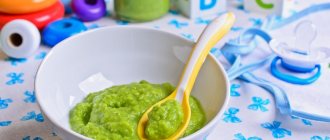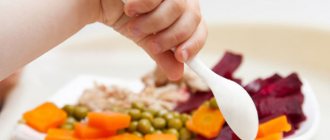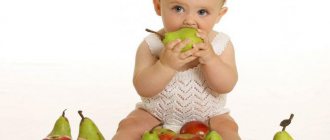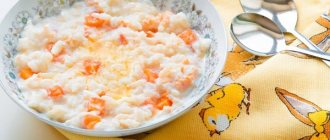Important Foods for Four Year Olds
A balanced diet always has a positive effect on the health of children.
This is an integral part of the proper development of the growing body. When thinking over the weekly menu for a preschool child, special attention should be paid to the following products
Meat and meat products
During the period of intensive growth, meat becomes the main supplier of energy and protein for the child's body. Unlike the diet of a child aged 1-3 years, meat can now be safely included in the diet. Kids will like the prepared meat dishes - these can be meatballs, cutlets or baked meat in the oven, which children love. Little gourmets will also enjoy meat stewed in the form of a stew or roast with vegetables, as well as gravy for side dishes.
Sausages and sausages are not always suitable for replenishing protein reserves. There is not enough real meat in the store assortment, and such products are considered harmful to children due to chemical additives of the E series and high salt content.
Fish and dishes made from it
This product contains calcium, phosphorus, iodine and other beneficial minerals. They are extremely necessary for the development of the skeletal system and the proper formation of the skeleton. Fish is a source of vitamins that strengthen the child’s immunity.
The iodine contained in sea fish supports the baby’s nervous system and promotes the development of intelligence.
Cottage cheese, sour cream, milk, kefir
Dairy products contain essential calcium, which is involved in the strengthening and formation of healthy and strong bones and teeth. During the period of changing baby teeth to permanent ones, fermented milk products are simply necessary in the child’s menu.
The beneficial properties of lactic bacteria will support healthy microflora and provide strong immunity.
Chicken and quail eggs
This product is also necessary in the menu of children over 4 years of age due to the beneficial properties of vitamin D contained in the yolk. Egg yolk also contains substances necessary for the proper functioning of the nervous and immune systems. Egg white is actively involved in building muscle tissue.
In addition, scientists have found that eggs are easily digested in the child’s body. This is a product that energizes and helps cope with drowsiness.
Oils: butter and vegetable
When preparing lean vegetable dishes, it is worth remembering the need to add a tablespoon of oil to the finished dish.
Vegetable oil (sunflower, olive or corn) is rich in omega fatty acids, which is very important for the maturing body
Like cottage cheese, butter containing calcium is also important
Just pay attention to the fat content of butter. 82% of cream is considered natural butter
Everything below contains additional plant impurities.
Fresh fruits and vegetables
For proper bowel function, fiber is needed in fresh fruits and vegetables. However, fruits should be given before afternoon tea for complete digestion and absorption.
The norm of vegetables and fruits per day for a child is 250 g.
Diet examples
If the children's menu is compiled correctly, the child gets sick less often, is less susceptible to infection with viruses, feels better and is ready to learn and play. Your daily diet should include meat, dairy products, grains, fiber and oil. Bread must be present in the daily diet of children. Children under 3 years of age are offered black or gray bread, while older children are given a choice of white or black. Several times a week, children are given cottage cheese, fish, eggs and cheese.
In addition, the children's menu must include juices, fruit compotes, jelly, and jelly. For an afternoon snack or second breakfast, children are offered fresh fruit as a snack. Seasonal berries are added to the summer menu.
Here is an example of the correct menu for a week for a kindergarten.
Monday:
- breakfast: semolina porridge, chicory coffee drink with milk, sandwich with butter and cheese;
- second breakfast: “snowball” 200 ml, shortbread;
- lunch: rassolnik soup, pasta, beef goulash with gravy, bread, compote;
- afternoon snack: fruit juice and half an apple (60 g);
- dinner: boiled white sea fish fillet, Polish vegetables, tea with sugar, cookies.
Tuesday:
- breakfast: barley porridge with milk, tea, cookies;
- second breakfast: omelet, apple juice;
- lunch: borscht with beans and sour cream, potato casserole, dried apricot compote;
- afternoon snack: kefir 200 ml, curd mass;
- dinner: chicken in sour cream sauce, vegetable stew, berry juice.
Wednesday:
- breakfast: oatmeal with milk, bun, sweet tea;
- second breakfast: pancakes with sweet filling, vitamin juice;
- lunch: cream soup with croutons, beef meatballs with gravy, noodles with butter, fruit compote;
- afternoon snack: yogurt, seasonal fruit;
- dinner: dumplings with potatoes, tea.
Thursday:
- breakfast: milk soup with noodles, bun, cocoa;
- second breakfast: pancakes, condensed milk, tea;
- lunch: soup with lazanka, white sea fish fillet, rice, fresh apple compote;
- afternoon snack: “snowball” 200 ml, butter pastries;
- dinner: peppers stuffed with meat and rice, tea with sugar, bagels.
Friday:
- breakfast: buckwheat milk porridge, gingerbread, cocoa;
- second breakfast: fruit jelly;
- lunch: kharcho soup, mashed potatoes, fish, berry juice;
- afternoon snack: sea buckthorn jelly, bun with raisins;
- dinner: macaroni and cheese, tomato and cucumber salad, tea with lemon.
Any menu for the week is approved by the head of the kindergarten. Each parent can familiarize themselves with such a menu independently when entering the group. Private kindergartens tend to offer a more varied and interesting menu for children, since such institutions have an unlimited budget and can choose not only those products that are supplied to the kindergarten by an approved supplier.
Thursday
Breakfast 60 rub.
Composition of the dishPortion gMilk semolina porridgemilk, semolina, sugar200Lunch 210 rub.
Composition of the dishPortion (g)Chicken noodles chicken (fillet), noodles, carrots, onions, chicken broth, salt 250 Lazy cabbage rolls beef, pork, cabbage, onion, bread, breadcrumbs, water, salt 100 Mashed potatoes potatoes, milk, butter 150 Vegetable vinaigrette potatoes, beets, carrots, pickled cucumber, green peas, vegetable oil60Compote 25 rub.from frozen berries200Afternoon snack 85 rub.
Composition of the dishPortion (g)Cottage cheese casserolecottage cheese, semolina, sugar, salt, egg, vanillin150Dinner 150 rub.
Composition of the dishPortion (g)Boiled chicken without bonechicken (fillet)100 Buckwheat, butter, salt, water150This set of four children's meals a day with compote for lunch costs 460 rubles.Main products in the menu of a one-year-old child
Meat should be present in a child’s diet every day, up to one hundred grams.
It could be:
- Beef;
- Pork;
- Bird;
- Rabbit.
Consumption of by-products is allowed; liver is considered especially useful due to its high iron content. You can cook the heart or tongue, but it is better in a stuffed form, such as meatballs or meatballs. Animal fats enter the body along with meat, but vegetable fats are also necessary.
You can include fish in your child’s diet twice a week, and on this day you don’t have to give meat. The variety should be selected carefully so that it is lean and boneless. This could be sea bass, cod or pike perch.
Dairy products continue to form the basis of the child’s diet. Daily consumption of up to 650 ml is required. At this age, you can consume fermented milk products, which must be fresh and reliably prepared.
The daily menu of a one-year-old child for each day should not exceed 1200 - 1250 ml in volume.
Cottage cheese can be diluted with low-fat sour cream and given to the child up to 40 g daily. One meal should consist of porridge. Corn and buckwheat are considered the most valuable. You can offer your child oatmeal, rice, millet and wheat porridge.
A child can consume up to 100 g of white bread per day. Occasionally, it is possible to include in the diet pasta, which contains fast carbohydrates and can be consumed as a side dish or as part of soups. It is necessary to gradually include butter in porridge or puree.
Due to the allergenicity, eggs are introduced into the child’s diet carefully, and only chicken or quail eggs. Can be served boiled or as an omelette
It is advisable to add oil to the dish at the end of cooking, so as not to subject it to prolonged processing and it does not produce a carcinogen.
For sweets, a one-year-old child should receive marmalade or jam. Honey is also useful if it does not cause allergies. Dried fruits and cookies are allowed.
Basic Rules
Your child must learn the following basic rules:
- eat enough at night - live in the future on a diet;
- crackers, crackers and chips cannot be considered a complete meal, these are bad, harmful foods;
- meals should be regular.
Eating discipline helps you effectively absorb nutrients from a variety of foods. It is important to launch a reflex algorithm for the activity of the children's digestive system on a clock basis.
Parents should learn the basic principles regarding healthy eating for their children.
The daily menu of a primary school student should be divided into at least 4 meals. Too large gaps should not be allowed between each of them, otherwise the risk of a sharp deterioration in health increases. This is especially true for eight-year-olds who lead an active lifestyle and those who attend a lot of extracurricular activities.
For example, a young hockey player who spends a lot of effort in training needs more food than a girl who paints. For young athletes, there are special diets that are recommended to be followed.
What to avoid while eating healthy
The PP menu for a week for weight loss will be easier to follow if you avoid situations that provoke breakdowns:
- Lack of sleep and overexertion. Losing weight is stressful for the body, and it tries with all its might to save energy. Therefore, you want to sleep more, and the feeling of fatigue comes earlier than usual. During this period, you should not exhaust your body; it is better to sleep an extra few hours.
- Avitaminosis. To maintain good health during the transition to proper nutrition, you need to drink vitamins, since the body is in a stressful state. It is also recommended to drink fish oil, which replenishes essential fatty acids.
- Alcohol. Alcoholic drinks have a high sugar content, so it is better to avoid them altogether.
- Don't go to the store hungry.
- Monotony. You cannot create one PP diet for a week for weight loss and eat like that for a month. The menu needs to be changed every week to avoid breakdowns.
Weekly menu for a child 4-5 years old - advice from a nutritionist
› 3-7 › Nutrition › Healthy nutrition for a child aged 4-5 years: a weekly menu from a children's nutritionist
Healthy nutrition for a child aged 4-5 years should be based on the principle of variety and balance. In addition, it is necessary to take into account the age-related characteristics of the functioning of the child’s gastrointestinal tract.
Healthy nutrition for a child, according to our consultant Tatyana Klets, pediatrician of the highest category, candidate of medical sciences, pediatric nutritionist, should also take into account the portion size acceptable for a child at this age. Unfortunately, modern mothers with the best intentions naturally often overfeed their children. Therefore, in her recommendations, Tatyana Klets gives the serving size in grams. Please take note of this!
4 quick and delicious baking recipes for children
A single serving size for a child aged 4-5 years is 450-500 g (including the drink), the cooking method should remain gentle (boiled, baked, stewed dishes), however, 1-2 times a week you can include dishes prepared using frying.
Fatty meats, hot seasonings and sauces (ketchup, mayonnaise, mustard, etc.) are not recommended. You should also avoid products containing artificial additives (dyes, flavors, preservatives, etc.).
), and also do not abuse allergenic products (chocolate, cocoa, citrus fruits).
Indispensable in the diet of children are: milk and dairy products, meat, fish, eggs. Meal times (breakfast, lunch, afternoon snack, dinner) should be constant, time deviations should not exceed 30 minutes. So, an approximate weekly diet:
Monday
Breakfast:
- Oatmeal porridge with milk 200 g
- Bread with butter and cheese 30/5/30
- Cocoa with milk 200 g
Dinner
- Salad (seasonal) 50 g
- Borscht with sour cream 150 g
- Pilaf with meat 100 g
- Rose hip decoction 150 g
- Rye bread 30 g
Afternoon snack
- Curd casserole 200 g
- Honey 30 g
- Kefir 200 g
- Biscuits 30 g
Dinner
- Vegetable stew 200 g
- Chicken ball 100 g
- Cranberry juice 150 g
Tuesday
Breakfast
- Rice milk porridge 200 g
- Quail egg omelette 100 g
- Milk 100g
- Bread with butter and cheese 30/5/30 g
Dinner
- Squash caviar 40 g
- Buckwheat soup with meat 150 g
- Boiled potatoes with butter 100 g
- Fried fish 60 g
- Rye bread 30 g
- Compote 100 g
Afternoon snack
- Natural yoghurt 200 g
- Bun with jam 30/30 g
- Fruits (apples, bananas) 200 g
Dinner
- “Lazy” dumplings with sour cream 250 g
- Tea with milk 150 g
- Canned fruits (peaches) 100 g
Wednesday
Breakfast
- Vermicelli “navy style” 200 g
- Fruit and berry jelly 150 g
- Fruit 100 g
Komarovsky reminded why fast food is dangerous for children and how to reduce harm
Dinner
- Salad (seasonal) 50 g
- Vegetable soup with meat 150 g
- Pearl porridge 100 g
- Meatball 70 g
- Fruit juice 100 g
- Rye bread 30 g
Afternoon snack
- Natural yoghurt 200 g
- Cupcake with raisins 100 g
Dinner
Thursday
Breakfast
- Buckwheat porridge with milk 200 g
- Gingerbread 50 g
- Cocoa with milk 150 g
- Fruit 100 g
Dinner
- Salad (seasonal) 50 g
- Rassolnik with sour cream 150 g
- Stewed potatoes 100 g
- Fish cutlet 60 g
- Fruit and berry compote 100 g
- Rye bread 30 g
The kingdom of sweet gifts: simple and safe recipes
Afternoon snack
- Cheesecakes with sour cream 200 g
- Milk 100 g
- Shortbread cookies 30 g
- Fruit 100 g
Dinner
- Flocked vermicelli 200 g
- Vegetable salad 100 g
- Boiled egg 1 pc.
- Tea with milk 150 g
Friday
Breakfast
- Pancakes with apples, jam 200/30 g
- Fruit 100 g
- Milk 150 g
Dinner
- Salad (seasonal) 50 g
- Chicken noodle soup 150 g
- Boiled rice 100 g
- Boiled tongue 80 g
- Fruit compote 100 g
Afternoon snack
- Cottage cheese with sour cream, jam 200/30 g
- Fruit juice 150 g
- Shortbread cookies 30 g
Dinner
- Stuffed cabbage rolls with meat 200 g
- Vegetable salad 50 g
- Tea with milk 150 g
- Fruit 100g
Saturday
Breakfast
- Millet milk porridge 200 g
- Boiled egg 1 pc
- Fruit 60 g
- Milk 200 g
Dinner
- Salad (seasonal) 50 g
- Pea soup, croutons with garlic 150/30 g
- Buckwheat porridge with butter 100 g
- Steam cutlet 70 g
- Fruit and berry juice 100 g
Afternoon snack
- Yogurt 200 g
- Fruit 150 g
- Butter bun 30 g
TOP 5 important rules for children's breakfast
Dinner
- Vegetable stew, liver 150/100 g
- Hard cheese 50 g
- Milk 150 g
Sunday
Breakfast
- Pearl barley milk porridge 200 g
- Omelette 50 g
- Milk 150 g
- Fruit 100 g
Dinner
- Salad (seasonal) 50 g
- Bean soup 150 g
- Boiled rice 80 g
- Baked fish with lemon 60 g
- Fruit and berry juice 100 g
Afternoon snack
- Milk 200 g
- Shortbread cookies 30 g
Dinner
- Cheesecakes with sour cream, jam 150/30 g
- Fruit 100 g
- Tea with milk 150 g
Children's menu: 6 ideal meat dish recipes for little gourmets
The editors' opinion may not coincide with the opinion of the author of the article.
Organizing nutrition for a 7 year old child
Shaping the diet of 7-year-old children requires a special attitude. At this age, the child becomes selective in food. Therefore, you will have to think through the children's menu, taking into account not only the degree of healthfulness of the products, but also the taste preferences of your beloved child.
The food must have enough calories to provide the child with energy throughout the day. The average norm that he should receive per day is 2400-2500 kcal.
One of the main elements of a balanced diet for 7-year-old children is the regimen. Only if this is followed will the body receive energy evenly and in a timely manner. For younger schoolchildren, it is recommended to eat at least 4-5 times a day.
This is what a sample meal schedule looks like:
- 07.00-07.30 – breakfast;
- 09.30-10.00 – second breakfast (at school);
- 12.30-13.00 – lunch (at school or at home);
- 15.30-16.00 – afternoon snack;
- 18.30-19.00 – dinner;
- 21.00 – light dinner (optional).
The first breakfast at home is an obligatory component of the diet of children of this age. It is advisable that the menu include milk porridge, a bread and butter sandwich, cocoa or tea. Be careful that your child does not overeat: a full stomach will negatively affect the learning of educational material.
If you give your child a snack for school, place it in an airtight container rather than in a plastic bag. Second breakfast can be: a savory bun or sandwich, banana, cookies, juice or fruit drink.
Lunch is always soup for the first course, meat or fish with a side dish for the second. A vegetable salad seasoned with sunflower oil or sour cream is also desirable (dressing with mayonnaise is unacceptable). For drinks, dried fruit compote is best; for dessert, you can give a chocolate bar.
The afternoon snack usually takes place at home. It's good if you offer your child pudding or casserole and fresh fruit (apple, kiwi, pear). A great option: oatmeal or corn cookies with milk.
The dinner of a 7-year-old child should be light and not repeat the dishes that he has already eaten during the day. Mom needs to carefully study the school menu to avoid repetitions. For dinner, dietary steamed meat (rabbit, chicken, turkey) or fish and a side dish of cereals or stewed vegetables, as well as an omelet cooked in a steamer or in the oven are perfect.
An additional light dinner is included in the daily diet of children 7 years old if desired. This could be a glass of kefir, fermented baked milk or warm milk. But it is important to drink it no later than an hour before going to bed.
What foods should be included in the diet of seven-year-olds?
A child’s body at 7 years old needs nutrients from 5 groups:
- proteins (norm – 80 g per day, of which 48 g are animal proteins);
- fats (norm – 75-80 g per day);
- carbohydrates (norm – 300-350 g per day);
- vitamins;
- minerals (calcium, iodine, iron, phosphorus, magnesium, and others).
Proteins (proteins) are the main building materials for body cells. Proteins are associated with: growth, metabolism, muscle contractility, transmission of impulses along nerve fibers, formation of immunity. It is especially important to consume proteins in childhood, and both plant and animal sources are needed, as well as dairy products.
Nowadays, the phenomenon of vegetarianism, which advocates a complete rejection of animal proteins, has become popular. But healthy baby food must include this component, and its exclusion or limitation is unacceptable. A lack of animal food is fraught with pathologies in the mental and physical development of a child.
Photo: depositphotos.com Author: pavsie
Protein foods should be included in the diet of a seven-year-old child on a regular basis. These include:
- lean meat;
- sea and river fish;
- milk – up to 500 ml per day;
- dairy products;
- cottage cheese, daily volume – 40-50 g;
- cheese;
- legumes: beans, peas, lentils;
- nuts: walnuts, hazelnuts, peanuts, cashews;
- eggs.
Fats are part of every cell in our body. They, like proteins, can be plant or animal. Animal fats are rich in vitamins A and D, while vegetable fats are rich in vitamin E.
The diet of a primary school student must include both types of fats. In this case, the volume of animals should ideally be 2 times the volume of plants.
Foods rich in fats:
- various unrefined vegetable oils: sunflower, soybean, olive, corn, etc.;
- nuts: Brazilian, cashew, walnut;
- fatty fish: herring, salmon, chum salmon, pink salmon, etc.;
- cream;
- sour cream;
- cheese;
- butter.
Carbohydrates are the main supplier of energy for a growing body. It is desirable that the need for carbohydrates in children 7 years of age be covered mainly by including cereals and cereals in the children's menu. These are sources of “slow” carbohydrates that supply energy to the body for a long time. But the volume of “fast” carbohydrates (cakes, cakes, sweets) should be no more than 10-20% of the total volume per day.
Foods rich in carbohydrates:
- cereals, cereals: buckwheat, rolled oats, corn, barley, pearl barley, rice, etc.;
- legumes: peas, beans, chickpeas;
- durum wheat pasta;
- dried fruits: dried apricots, raisins, prunes;
- corn;
- potatoes, zucchini, pumpkin;
- bananas;
- bread products made from wholemeal flour;
- jam, honey, jams, marmalade.
Vitamins and minerals must be supplied to the child with food. The main sources of minerals and vitamins are:
- fruits (required volume – 300 g per day);
- vegetables (volume – 280 g per day);
- berries and greens;
- milk and dairy products;
- meat and fish;
- cereals.
The basic principle of preventing a lack of minerals and vitamins in children 7 years old is a varied children's menu.
Particular importance should be given to the drinking regime of a 7-year-old child. The total volume of water that he should consume per day is 50-70 ml per 1 kg of weight, that is, approximately 1400-1500 ml.
The required volume is achieved through the consumption of soups, drinks (tea, cocoa, milk, juices, compotes, fruit drinks) and clean drinking water.
Read, this is interesting: At what age can a child be given cocoa?
What foods should be avoided on a seven year old's menu?
It is not advisable to include the following products in the children's menu:
- Sugar does not provide any benefit, only “empty” calories. But it worsens the condition of teeth and is a common cause of childhood obesity.
- Refined wheat flour, like sugar, does not have valuable health qualities.
- It is better to replace white wheat bread with rye or bran bread.
- Products with dyes, preservatives, flavors, food additives (labeling starting with the letter “E”).
- Margarine is a source of trans fats that disrupt digestion.
- Vegetables and fruits sold out of season are treated with dangerous chemical fertilizers and pesticides.
- Store-bought sauces, ketchup, mayonnaise, mustard.
- Sweet carbonated drinks.
The health of 7-year-old children is closely related to nutrition. Poorly organized baby food will not go unnoticed for the child and will certainly affect the general physical condition and academic performance. But the right menu will serve as the key to strong immunity, excellent health, physical and mental activity of your child, which will entail success in school and throughout his subsequent life.
The diet of a 7-year-old child is much more varied than even the menu of a six-year-old child. Take even the fact that the menu of a 7-year-old child is allowed to include smoked and stuffed fish, bell peppers, jellied meat, turnips with apples and raisins, ham and sausage. Nutritionists allow you to enhance the taste of a children's dish with the help of sauce, herbal seasonings, mustard, pepper or horseradish, just do not overdo it.
Children love sweets and delicious homemade cakes, so we strongly recommend pampering your baby with healthy culinary masterpieces of your own making. This could be apple pie or pies with yeast dough, oatmeal cookies, charlotte, pancakes with cottage cheese, etc. As a dessert, you can pamper your seven-year-old sweet tooth with candies, ice cream, jelly, marshmallows and marmalade, but not often.
Many children love to drink liquids so much that many mothers jokingly call them “waterbreads.”
What can you offer a 7 year old child to drink?
This, as before, can be pure water (you can indulge in carbonated water), compote of fresh berries or dried fruits, tea, cocoa, juice from any fruit, milk, carrot or tomato (if it does not cause allergies) juice, water with honey and lemon . Nutritionists prohibit giving a child 7 years old coffee and strong tea, as they contain caffeine, a substance that excites the nervous system.
At the age of seven, the child spends most of his time in kindergarten or at school, so he receives his main nutrition there. The little one has dinner at home, so it is advisable that the mother try to prepare a dish that should not repeat the daily food menu of a 7-year-old child, but rather complement it. To find out what your baby ate during the day, just look at the menu, which is posted in the parent's corner or at the entrance to the dining room. It is very good if there is always fresh fruit (of several types) at home, so that the child can always pamper himself with vitamins.
I draw the attention of parents to the fact that a seven-year-old child needs to be told about the rules of behavior at the table, and it is also time to accustom him to the rules of using cutlery (including a knife). The student should know that he needs to sit straight in a chair, not put his elbows on the table or spread them out, interfering with a neighbor sitting next to him, etc.
So that you can properly organize your baby’s meals on weekends, I bring to your attention an approximate menu for a 7-year-old child:
Breakfast:
- 20 grams of boiled pasta with grated cheese (10 grams)
- 200 ml tea with milk or cocoa
- 50 grams of loaf or white bread +5 grams of butter
Dinner:
- 50 grams of squash or eggplant caviar
- 150 ml rassolnik, borscht or meat broth soup
- 8o grams fried fish or fish cakes
- 70 grams of mashed potatoes + 30 grams of green peas
- 150 grams of drink (compote, fruit juice, water with lemon and honey)
- 60 grams of black bread.
Afternoon snack:
- 50 grams of apple pie or muffin with cottage cheese
- 200 grams of kefir
- 100 grams of fresh fruit
Dinner:
- 200 grams of cabbage meatballs (cutlets) with tomato-sour cream sauce
- 150 ml milk
- 50 grams of white bread.
Remember that a child should eat 1800-1900 grams of food per day, including 250 grams of first course, 80 grams of fish or meat or dishes with them, as well as 100 grams of side dish.
To decide what dish and how to cook for a seven-year-old child, I recommend looking at culinary sites or books that contain recipes for children 7 years old. Some mothers have become subscribers to newspapers on baby food, for example, “Tsar Culinary,” or magazines, for example, “Cooking for Children,” “Cooking at Home.”
If a 7-year-old child does not eat, then try to change the menu a little, cook something original. For example: he refuses boiled potatoes - so prepare a potato casserole with meat or does not want to eat buckwheat porridge - prepare buckwheat cakes. If these tricks do not give a positive result, then show the child to a doctor: a therapist and a nutritionist. They will be able to figure out the cause and prescribe medications that induce appetite. As a rule, these medicines are made from herbs, are harmless and have a positive effect on the child’s body.
Classic breakfast
Here are recipes that some mothers dream about with a sigh - if only someone would eat it. Then they, too, could indifferently throw out in a conversation: “I don’t understand why children should be poisoned with rolls!” Cottage cheese, cereals, yoghurts and egg dishes are the most popular breakfasts in our country. The recipes below take time, we did not take options from Captain Obvious, like fresh cottage cheese with berries. And, of course, the recipes do not meet the PP standards - these are just healthy breakfasts without calculating the KBJU.
Mix cottage cheese with egg, add dry foods. You can beat it with a blender for tenderness. Fill silicone/ceramic molds with the mixture (not to the top). Bake for about half an hour at 180.
Oatmeal pancake
Pour oatmeal with hot milk or water and leave for 5-10 minutes. Then, when the mass has cooled slightly, beat in the eggs. The second option is without soaking: the flakes need to be ground, but not to powder, then mixed with eggs and milk. This amount of mixture is designed for two pancakes. In a hot frying pan, fry the pancake on both sides for 3-5 minutes with or without oil.
Curd pancakes
Lightly beat the eggs with sugar, add cottage cheese, and grind with a masher to make a puree. Add milk and stir, then mix in flour. Pour in the oil and leave for 20 minutes. Bake over medium heat. The dough can be prepared in the evening, then in the morning you will need to dilute it a little with milk.
Omelette in cup No. 1
A tureen-type cup is suitable for omelettes. Beat the eggs with a fork with milk, add tomato pieces, cheese, and herbs if desired. At this time, melt a little butter in a mug or grease it with vegetable oil. Cook the omelet in a slow cooker for 5 minutes at the highest power.
Omelette in cup No. 2
Beat the eggs with sour cream directly in a pre-greased mug. Cook in the slow cooker for 3-4 minutes on high.
Mix all ingredients. If you use a blender, the mass will be airy and tender. Fry covered until done.
Carrot pancakes
Grate the carrots on a fine grater and mix with the rest of the ingredients. Place a spoonful of the mixture in a frying pan heated with oil, fry over medium heat for 3 minutes on each side.
| Fact one - not all children like school food. The second fact is that among children there are a lot of picky children, those with little teeth, and also those who are on a special diet. Fact three: you still need to eat. If all this is about your schoolchildren, read on. |
Dinner
Lunch usually starts at 12.30. The child will eat better if before lunch he walks in the fresh air, pumps up on the swing and plays with other children. For the first course, soup is usually prepared, for the second - a vegetable dish with meat or fish cutlets.
Borsch
Ingredients:
- Beetroot – 200 g;
- Potatoes – 300 g;
- Cabbage – 300 g;
- Carrots – 330 g;
- Zucchini – 300 g;
- Onion - half;
- Bay leaf;
- Greenery.
Chop cabbage and onions, grind beets and carrots, cut potatoes and zucchini into small cubes. Add water and cook until done. 5 minutes before the end of cooking, add bay leaf. After the soup is poured into bowls, garnish the dish with herbs or thin slices of fresh carrots.
Fish soup
Ingredients:
- Red or white fish – 200 g;
- Potatoes – 2 pcs;
- Carrots – 1 piece;
- Rice - a third of a glass;
- Bay leaf;
- Greenery.
Cut potatoes and carrots into 1*1 cubes and cook in water. A few minutes before the end of cooking, add bay leaf to the broth. At the same time, steam the fish, remove bones and skin. It is better to cook the rice separately. Combine with the rest of the ingredients and mix. If the potatoes and carrots are too large, it is better to grind them or cut them into smaller pieces. Before serving, garnish with herbs.
Turkey meatballs
Ingredients:
- Fillet – 500 g;
- Cabbage – 250 g;
- Small onion – 1 piece;
- For the gravy:
- Vegetable puree or juice – 1 glass;
- Water, vegetable broth, meat broth - 2 cups;
Grind the skinless vegetables to make a puree. Mix the flour with water (broth, broth) thoroughly so that there are no lumps left. Bring the vegetable puree to a boil, pour in the liquid with mixed flour, bay leaf, dill, cook for another 10 minutes. Decant and it turns out to be gravy.
Grind the meat, cabbage, and onion in a meat grinder, prepare the minced meat and form it into balls. Place them in boiling broth and cook for 25 minutes.
Steamed fish pots
Ingredients:
- Sea sole fillet (can be replaced with other white fish) – 700 g
- Carrots – 350 g;
- Bread – 200 g.
Grind the fish, carrots and bread through a meat grinder, shape the resulting minced meat into cutlets and steam for 25 minutes.
Diet
For most 2-year-old children, four meals a day are sufficient. Pediatricians recommend feeding your baby on a schedule, taking a break between feedings of 3.5-4 hours.
If your child eats his first meal at 8:00 am, feed him lunch at 12:00 pm. After a nap, prepare a light but satisfying afternoon snack - at 15-30 - 16-00. And call me for dinner at 19-00.
- For breakfast, the basis of nutrition should be porridge with the addition of a small amount of butter or fruit. Pair it with tea and a sandwich or cookies.
- For lunch, cook a first course for your baby, add a vegetable side dish, meat or fish - cutlets, cabbage rolls, meatballs, stewed or baked.
- Curd dishes, fruit salads, milk, cookies, cocoa, yoghurts, juices are food options for an afternoon snack.
- For dinner, prepare porridge or pasta, stewed or boiled vegetables, and a meat casserole.
This schedule is designed for a healthy child. Weakened, often sick babies need enhanced nutrition. In addition to the main meals, add a second breakfast and a snack before bed after dinner.
Allowable amount of food per day for proper nutrition:
| Category | Norm per day, g |
| Milk, dairy products | 350-400 |
| Vegetables | 250-350 |
| Fruits | 120-150 |
| Meat | 100-140 |
| Fish | 160-180 g per week |
| Eggs | 1 time every 2 days |
| Bakery products | 90-120 |
| Liquid: water, compotes, teas, juices | 400-420 |
Don’t have hearty snacks, your baby won’t have time to get hungry before the next meal. Get him personal cutlery - a plate with a picture of a fairy-tale character, a fork and spoon with a colored handle, colorful napkins.
It is worth taking into account the baby’s preferences, otherwise he will be capricious and refuse to eat at all.
Study the preferences and tastes of the little person, do not try to feed him against his will - next time he may refuse to eat altogether.
Meals at school
Since students spend a lot of time in classes, the school cafeteria must serve a varied and complete menu, which changes every week. At breakfasts you can often find manna and porridge - what is necessary for active mental activity.
For lunch, as a rule, they give soups and salads, and for the main course - potato dishes, fish, pasta, meat, poultry, etc. Fish is an important product in the diet of any schoolchild.
Sea fish, which is healthy for children, has been highly praised by children's nutritionists, because it is rich in all the beneficial substances that schoolchildren need. Seafood has a good effect on the mental development of children of all ages (not just 8-year-olds) and, most importantly, maintains a stable state of the cerebral cortex, so you can’t do without them in your diet. The main thing is to follow the rules of hygiene when preparing and subject the products to thorough heat treatment.
Modern parents should control not only their child’s home meals, but also the school menu, since your child eats at school 5-6 days a week. But if for medical reasons your child is prescribed a diet, catering will not suit you.
Correct mode
For four-year-old children, four meals a day should be provided. In the morning, breakfast is required, followed by lunch, afternoon tea and dinner. Before bed, you can offer your baby a glass of kefir with cookies or milk. The calorie content of food per day for a 4-year-old child is 1700 kcal. The main set of calories is designed for the first half of the day: breakfast and lunch.
Kids eat dinner with special pleasure, having spent a huge amount of energy before it. For dinner, be sure to serve vegetables and any protein (meat, fish) - this is the building material of muscles. Fruits should be offered no later than the afternoon snack, as the process of digesting them can cause gas formation, which is not advisable before bedtime.
Make sure your 4-year-old child drinks enough fluids. These can be juices, compotes, decoctions and just teas.
Also don't forget about bread. At each feeding, offer your baby a piece of bread. It should not be very fresh or black bread, as these 2 types are hard on the stomach of a 4-year-old child.
Not all children's bellies can handle the digestion of black bread - it is highly acidic and can cause discomfort in the little one's stomach.
Special dietary recommendations
Children at 3-4 years old can already eat fully from an adult table. However, you should not feed children at such an early age fatty and fried meat, the crispy crust on which is an accumulation of carcinogens, and they are dangerous even for an adult.
Processing methods for menu products should be gentle, including boiling, stewing or baking
Particular attention should be paid to the complete readiness of meat and fish - to avoid the ingress of microbes from undercooked animal products
Steaming vegetables keeps healthy vitamins and minerals intact
All that remains is to explain to the baby the importance of eating vegetables, no matter how much he resists. At 4 years old, a child is quite capable of thinking and drawing conclusions about the benefits of a particular product.
At this age, it is important to have a complete supply of protein in the body - it is the building material of all muscles, organs and systems. The best protein companion for children is carbohydrates, which not only allow proteins to be absorbed, but also provide the energy necessary for a little tomboy, especially during periods of physical activity.
Products from the menu must comply with GOSTs, be fresh, with expiration dates taken into account. Juices and compotes should be selected without dyes and antioxidants, and even more so without preservatives. It's better to cook them yourself.
Meals must be organized at the same time for the coordinated functioning of the digestive and excretory organs, as well as for the nervous system, which functions more fully if the child’s daily routine and nutrition are observed.
At 4 years old, the baby is already a full-fledged member of the family, and, like adults, he should have a place at the table and his own cutlery.
The lack of vegetables and fruits in the menu of young children causes constipation, stagnation of digested masses in the intestines, resulting in disruption of metabolic processes, sleep and appetite. Make sure your children eat fruits and vegetables every day - this is the key to strong immunity!
Advice from pediatric nutritionists
In a balanced diet for primary schoolchildren, a key position is occupied by animal protein, which can be obtained from the meat of cattle or poultry, as well as fish. For the proper and complete development of an 8-year-old child, these products are simply necessary. But preference should be given to lean meats and lean fish.
The best options for heat treatment of children's dishes are steaming, stewing and baking in the oven. In this regard, nothing has changed since the introduction of the first complementary foods.
If you violate the rules prescribed by pediatricians, you can provoke a metabolic disorder in the child and, as a result, stomach and intestinal diseases, problems with learning, increased nervousness and excess weight.
An important point in proper baby nutrition is to enjoy eating. You can’t force it; the child must want to eat on his own.
The best diet is considered to be one in which food enters the stomach at certain time intervals. There should be intervals between meals: at least 3 hours and no more than 5. In the body of a healthy schoolchild, 4 hours after the next meal, the digestion of previously eaten food ends and the stomach becomes empty.
If a child eats properly, then his weight at 8 years old should be approximately 29 kg. This applies to both boys and girls. It is clear that this indicator cannot be applied to everyone without exception, because the ratio of height and weight is also determined by heredity.
Nowadays, it is often possible to encounter the problem of excess weight among the younger generation. If necessary, the doctor will recommend a special children's diet that takes into account the physiological characteristics of your child, as well as his medical history.
Weekly menu for a child 4-5 years old
A child who has reached 4-5 years of age already eats on an equal basis with older family members. Gone are pureed vegetables, cereals, and special recipes, but we must not forget that this period has its own developmental characteristics. When compiling a daily diet, these features should be taken into account first.
Some nuances of food consumption
At such a tender age as 4-5 years, a child should continue the tradition of eating 4 meals a day during one day. In this case, the meal time should be fixed so as not to upset the appetite and stimulate proper digestion. The baby is actively developing, moves a lot, grows, learns, and all these processes continue just as rapidly if his diet includes:
- Eggs
- Dairy
- Meat
- Chicken
- Vegetables fruits
- Cereals
- Fish
If parents abuse salt or spices while cooking, it is better to cook separately for the baby.
The gastric mucosa at such an early age can be seriously damaged, and this, in turn, can provoke diseases such as gastritis. Naturally, every child loves sweets, the intake of which can only be controlled by parents. If you decide to pamper your child, they can be offered after lunch is eaten or during the afternoon snack.
Amount of food consumed throughout the day
Depending on the age of the baby, the volume of the stomach increases. Already by 4-5 years it increases to 450-550 grams, which is directly related to the daily amount of food consumed.
If parents notice that their child is active, but eats very little, not reaching his norm, it is necessary to organize additional feeding. It would also be a good idea to visit a doctor who can recommend remedies to improve your appetite.
There is another problem - excessive appetite, leading to obesity and abnormal development. The diet of such a baby should be adjusted: slightly reduced with a predominance of vegetables and fruits.
Monday
Breakfast - rice porridge with pumpkin, a glass of cocoa, bread, butter, Lunch - cheese soup, meatloaf, pancakes seasoned with sour cream, fruit, bread. Afternoon snack - grated raw carrots, seasoned with sour cream, bun and kefir
Dinner – apple pie, milk
What can a child drink?
As at any other age, a 4-5 year old child cannot be limited in fluid intake. Constant play, active growth, climatic conditions and time of year stimulate moisture loss, which must be replenished.
That is why not a single meal can be done without kefir, milk or tea, and freshly brewed compote without sugar should be constantly “on duty” in the wings of the mother.
You just need to make sure that the baby does not drink a lot of liquid before sitting down at the table - because of this, his appetite will significantly worsen.
The menu provided is only a draft, which only caring parents can bring to perfection. When creating your own daily schedule, you need to try to make it as varied as possible, taking into account all the components necessary for the child, and all dishes are prepared exclusively before serving.
Requirements and norms of SanPiN
The organization of meals for schoolchildren is carried out taking into account the rules of sanitary and hygienic documents established at the legislative level.
Old standards
Until January 1, 2021, SanPiN 2.4.5.2409-08, approved on July 23, 2008, was in force. Their validity period extended until 2023. However, the rapid development of society led to the fact that these standards became outdated: new products appeared, were supplemented and changed WHO recommendations.
In March 2021, a new edition of sanitary standards appeared. It came into force at the beginning of next year and is valid until its end.
Last changes
From January 1, 2021, standards approved by SanPiN 2.3/2.4.3590-20 come into force in Russia. Chapter 8 of the document regulates the rules for organizing meals for students. The new document includes additions to the list of prohibited products and clarifications of previously existing requirements.










